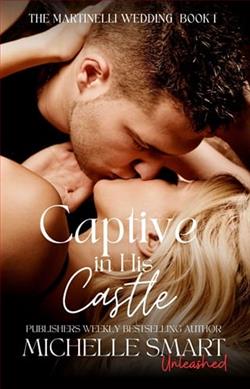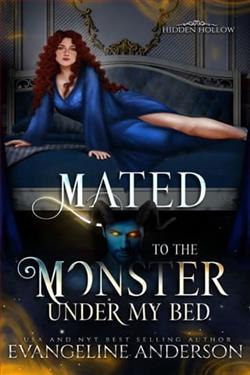Page 18 of Illicit Intent (Bishop Security 2)
New York City
April 17
Calliope stood at her open refrigerator with the phone to her ear and downed a bottled water. Her morning trip to the park with Coco had been uneventful, and she had embraced the chilly spring morning as they did their thing. They didn’t have a set routine. Today it was frisbee and people watching. Tomorrow might be squirrel-chasing and puddle-splashing—whatever the day brought. She scratched Coco behind her ears and pondered her stepfather’s question.
“I don’t have a clue. Europe would be fun.”
“Be nice to have you close by,” he said.
“I’ll miss New York. I love my house.”
“Keep it. You can visit, or maybe you’ll return one day.”
“Maybe.” She wouldn’t. “Give mom my love.”
“We’re taking the Calypso out for a couple of days. Lost at sea, just the two of us,” he said.
Calliope rolled her eyes. Her parents and their perpetual honeymoon.
“And the staff.”
He chuckled. “We love you hummingbird.”
“Love you too, dad.”
She felt his pleasure at the moniker. He ended the call with his usual sign off. “Seja sábio.” Be wise.
He never advised, be smart, or be careful, simply be wise. Calliope sighed. Wisdom felt a bit out of reach. Impetuous still seemed to be blocking the door for wisdom to enter. Oh well. She leaned against the kitchen island and took in her home.
Calliope’s Brooklyn Heights brownstone was too big for her, but she adored it. The ground floor was a garage-cum-studio apartment rented by a lifelong resident of the neighborhood; Mrs. Woodruff was a widow in her seventies currently visiting her daughter and grandchildren in St. Louis. The remaining three stories comprised Calliope’s home. The first floor had a shotgun layout consisting of a large, eat-in kitchen in the back, a formal dining room that currently served as a home office in the middle, and a large living room with an oriel window that looked out over the street. A wide hall with the original oak staircase and broad banister ran the length of the right side and linked the three rooms.
Other than her bedroom on the second floor, these were the only furnished rooms in the house. And furnished they were. The word that came to mind for most visitors was inviting. The kitchen and living room were predominantly pale blue and daffodil-yellow. The kitchen had a chipped-paint farm table and brass pots and pans hanging from a rack above the island. An arrangement of dried wildflowers filled the non-working fireplace. The living room was decorated with overstuffed furniture, colorful pillows, and cozy throws that made a guest never want to leave. The bay window that looked out over Sydney Place had a cushioned window seat and no curtains or shades; a story above street level, it was difficult to see in, and Calliope loved looking out at her neighborhood, at her freedom.
The wall opposite the bay was her favorite thing in the whole house. A mural she had painted on a whim. She took inspiration from her new surroundings and some paint she had found in a storage closet and gave free rein to her inner Basquiat. It wouldn’t receive accolades from the avant-garde, but she was pleased with the result. The rushing chaotic swirls of blue, gold, and turquoise seemed to converge at the center in a vortex. It was a bit like looking into a debris-filled tornado from above. And the pale void in the middle, that if you tilted your head just so, was heart-shaped? She didn’t give it much thought. She just liked her art.
After taking a quick shower and changing into yoga pants and a long sleeve t-shirt, Calliope was once again standing at her kitchen island eating a bowl of muesli. She upended her messenger bag and discarded a lip gloss that had lost its top on the sidewalk. She attempted to power on the shattered work phone and, when nothing happened, tossed it in her junk drawer with the slew of items—tape measure, screwdriver, packing tape, safety pins, a rasp, coral nail polish, batteries, a hole-punch—that she never used but never discarded. Then, she retrieved the flash drive and headed to her makeshift office with her cereal.
She perched on a balance ball at her dining room table—two parallel slabs of driftwood covered with glass and supported by four cut birch trunks at the corners—and scrutinized the documents she had downloaded as she ate. Coco lolled on her plaid flannel dog bed in the corner. Just as she withdrew a spare flash drive from her bag to copy what she had downloaded so Twitch could help her analyze the data, her personal phone chimed, and she glanced at the text. Speak of the devil.
Twitch: Knock knock.
The knock on the door startled her into a laugh. Coco barked and her nails tickled the hardwood as she scurried to the front hall. Calliope expected to see the spritely ginger, but when she pulled open the door her gaze met the sculpted chest of Miller “Tox” Buchanan.
“Don’t you check who’s at the door?” he growled.
“Twitch texted a stupid Matrix reference. I thought she was stopping by.”
Tox rolled his eyes. “She must’ve tracked me.”
“What’s up?”
He knelt down to give Coco a proper greeting. Glancing up from his crouch, he said, “A lot. Phipps Van Gent was found dead in his office this morning.”
“What?”
“We don’t have all the details yet. Someone shot him.”
“Oh, God.” She staggered back, then muttered something in another language Tox couldn’t make out. He guided her into the house and closed the front door.















